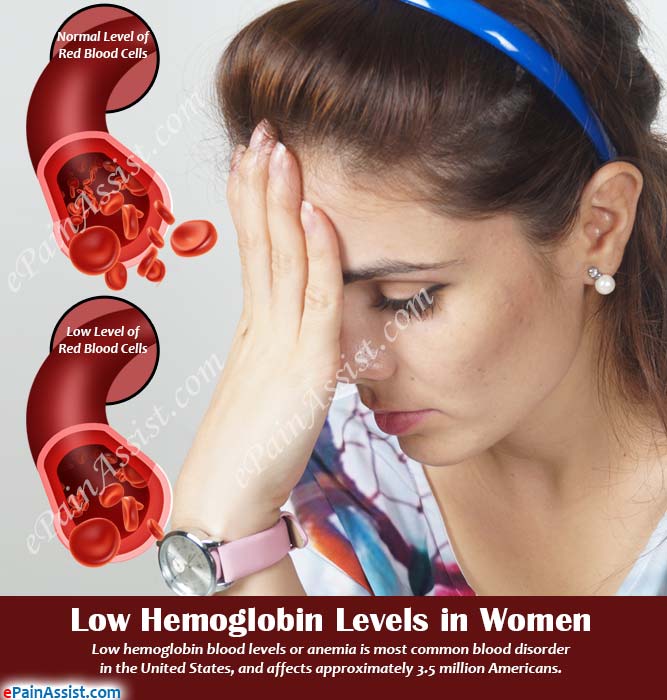Low hemoglobin blood levels or anemia is the most common blood disorder in the United States and affects approximately 3.5 million Americans. It is more common in women due to blood loss from menstruation and increased demand during the childbearing years, various medical conditions, and poor diet. Low Hemoglobin Levels in Women can affect health and also has great effects on menstrual cycle, which need to be understood.
Hemoglobin is a part of red blood cells and responsible for binding oxygen to them for its transport through the body. If red blood cells for some reason begin lacking hemoglobin, the rest of the body cells are not supplied with appropriate amounts of oxygen. The organ cells fail to receive the amount of oxygen they need in order to be able to function properly. This results in various symptoms of anemia, mainly including fatigue and sometimes fainting.

Low Hemoglobin Levels in Women
Low Hemoglobin Levels in Women or anemia has various types. They are caused by different factors and are treated with different medical procedures. Iron-deficiency anemia is the most common type of blood disorder and can be easily treated with dietary changes and consumption of iron supplements. Mild anemia or slightly low hemoglobin levels that develop at the time of pregnancy due to higher demands from the body is considered completely normal. However, some types of anemia can still induce lifelong health problems.
Low hemoglobin levels in the blood can induce various health issues, but can sometimes be treated easily, if you know how to. Low hemoglobin levels can also often cause irregularities in the menstrual cycle in women. It is important to know how Low Hemoglobin Levels in Women affect health and about its effects on menstrual cycle.
Causes of Low Hemoglobin Levels in Women
Low hemoglobin level in blood or anemia can be caused by various factors including the following:
- Iron deficiency.
- Vitamin B12 deficiency.
- Chronic lead poisoning.
- Genetic abnormalities (sickle cell anemia).
- Chronic red blood cell destruction.
- Sudden red blood cell destruction.
- Excessive blood loss.
- Pregnancy (mild anemia).
Symptoms of Low Hemoglobin Levels in Women
Early or mild stages of Low Hemoglobin Levels in Women may not show any symptoms. Normally, the body has a great ability to make up for the losses that anemia produces and cope up with the effects. However, if low hemoglobin levels in your blood cells have progressed, you might notice some symptoms produced by anemia.
The commonest symptoms experienced during Low Hemoglobin Levels in Women include:
- Loss of body energy, easy fatigue; constant or frequent tiredness.
- Unusually rapid heartbeats with certain physically stressful actions or exercise.
- Shortness of breath, headache, and other symptoms of body stress with exercise and other activities that may use a lot of body energy.
- Increased difficulty in concentrating.
- Other symptoms like insomnia, paleness of skin, leg cramps, dizziness, etc. may also be seen.
Low Hemoglobin Levels in Women & its Effects on Menstrual Cycle
Low hemoglobin levels in women can have detrimental effects on your menstrual cycle. Menstrual cycles result in great loss in blood and can often result in reduced hemoglobin. However, anemia can also affect them.
The following are some ways, in which Low Hemoglobin Levels in Women can affect the menstrual cycle:
- Irregularity in Menses – Low hemoglobin level affect your blood and can bring certain irregularities in your menstrual cycle. Apart from these variable irregularities, your anemia can also sometimes cause your period to stop. This is sometimes noticed in women who fail to supply themselves with enough nutrition and are underweight.
- Lack of energy: Low hemoglobin levels result in reduced oxygen supply to the body, which makes you feel less energetic. Not feeling the strength or urge to do anything, lack of energy is commonly seen and particularly more during menstruation.
- Fatigue: Fatigue is a common symptom of anemia, but can be more during menstruation. Increased loss of blood occurs during menses, due to which even lesser oxygen gets supplied to the body cells.
- Inability of the body to cope up: In many cases, it becomes hard for the body to cope up with daily stress. Women experience fainting, feel extremely tired, or experience chills, and other symptoms associated with great loss in body energy.
Treating Low Hemoglobin Levels in Women
Treatment of low hemoglobin levels in women depend on various types of anemia. It is important to reduce the effects on menstrual cycle.
The following is a list of some possible treatments for anemia, based on their types:
- Iron Deficiency Anemia: Treatment of low hemoglobin levels in women due to iron deficiency involves consumption of iron supplements and making variations in the diet to keep you supplied with enough iron.
- Vitamin Deficiency Anemia: Treatment of vitamin deficiency anemia also involves consumption of dietary supplements and making variations in regular diet to make up for this lack of nutritional resources.
- Anemia of Chronic Disease: Anemia of chronic disease has no specific treatment. The only treatment involved is curing the underlying medical condition.
- Aplastic Anemia: Aplastic anemia can either be treated with blood transfusion, or bone marrow transplant.
- Hemolytic Anemia: Hemolytic anemia, if mild, involves treatment by treating associated infections and consuming drugs that suppress the immune system. If severe, it can involve blood transfusion, plasmapheresis, or removal of the spleen.
- Sickle Cell Anemia: Treatment of sickle cell anemia involves supplying with required oxygen, use of pain-relieving medication, and prevention of further complications. Blood transfusion and bone marrow transplant are also possible treatments.
- Thalassemia: Thalassemia can be treated with medication, blood transfusion, removal of spleen, folic acid supplementation, and blood and bone marrow stem cell transplantation.
